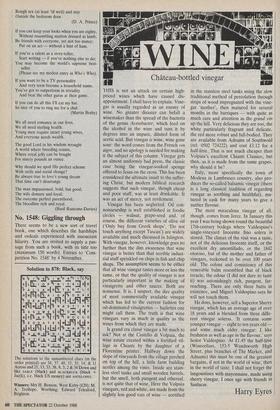Château-bottled vinegar
THIS is not an attack on certain high- priced wines which have caused dis- appointment. I shall have to explain. Vine- gar is usually regarded as an enemy of wine. No greater disaster can befall a winemaker than the spread of the bacteria of the genus Acetobacter, which feed on the alcohol in the wine and turn it by degrees into an impure, diluted form of acetic acid. But vinegar is wine, wine gone sour: the word comes from the French yin aigre, and no apology is needed for making it the subject of this column. Vinegar gets an almost uniformly bad press, the classic case being the vinegar-soaked sponge offered to Jesus on the cross. This has been considered the ultimate insult to the suffer- ing Christ, but modern biblical research suggests that such vinegar, though cheap and poor stuff, was at least drinkable. It was an act of mercy, not revilement.
Vinegar has been neglected. Oil con- noisseurship is well established in foodie circles — walnut, grape-seed and, of course, the different varieties of olive oil (`Only buy from Greek shops', 'Do not touch anything except Tuscan') are widely available and much discussed in Islington. With vinegar, however, knowledge goes no further than the dim awareness that wine vinegar is better than that terrible indust- rial stuff sprinkled on chips in fish and chip shops.. The assumption seems to be either that all wine vinegar tastes more or less the same, or that the quality of vinegar is not particularly important in the making of vinaigrette and other sauces. Both are nonsense. It is, I suspect, the dire quality of most commercially available vinegar which has led to the current fashion for oil-dominated vinaigrettes — huilettes one might call them. The truth is that wine vinegars vary as much in quality as the wines from which they are made.
Is grand cru classe vinegar a bit much to ask? Not at the Castello di Volpaia, the wine estate created within a fortified vil- lage in Chianti by the daughter of a Florentine printer. Halfway down the slope of vineyards from the village perched on top of the hill, a little farm building nestles among the vines. Inside are stain- less steel tanks and small wooden barrels, but the smell, both pungent and ethereal, is not quite that of wine. Here the Volpaia vinegars, red and white, are made from the slightly less good vats of wine — acetified
in the stainless steel tanks using the slow traditional method of percolation through strips of wood impregnated with the vine- gar 'mother', then matured for several months in the barriques — with quite as much care and attention as the grand yin up the hill. Very delicious they are too, the white particularly fragrant and delicate, the red more robust and full-bodied. They are available from Adnams of Southwold (tel. 0502 724222) and cost £3.12 for a half-litre., That is not much cheaper than Volpaia's excellent Chianti Classico, but then, as it is made from the same grapes, why should it be?
Italy, more specifically the town of Modena in Lambrusco country, also pro- duces the so-called balsamic vinegar (there is a long classical tradition of regarding vinegar as soothing and healthful), ma- tured in cask for many years to give a nuttier flavour.
The most miraculous vinegar of all, though, comes from Jerez. In January this year I was being shown round the beautiful 17th-century bodega where Valdespino's single-vineyard Inocente fino solera is stored. The climax of the visit was a taste, not of the delicious Inocente itself, or the excellent dry amontillado, or the 1842 oloroso, but of the mother and father of vinegars, reckoned to be over 100 years old. The colour and consistency of this venerable balm resembled that of black treacle; the odour (I did not dare to taste it) was astonishingly rich, pungent, far- reaching. There are only three butts in existence, and Miguel Valdespino says he will not touch them.
He does, however, sell a Superior Sherry vinegar, which has an average age of over 18 years and is blended from three diffe- rent vinegar soleras. 'It contains some younger vinegar — eight to ten years old and some much older vinegar: I like freshness as well as age in the flavour,' says Senor Valdespino. At £1.45 the half-litre (Winecellars, 153-5 Wandsworth High Street, plus branches of The Market, and Adnams) this must be one of the greatest bargains, if not in the world of wine, then in the world of taste. I shall not forget the langoustines with mayonnaise, made using sherry vinegar, I once age with friends in Sanlucar.
Harry Eyres


































































 Previous page
Previous page